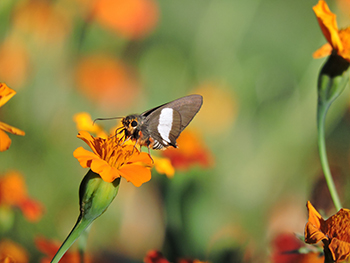
It is difficult to survey all different types of
plants and animals and is therefore necessary to
choose one representative group. Butterflies are
relatively cheap and easy to sample. They are
known to be linked to specific habitats and to
respond to human pressures, such as farming.
Photo: Dr Falko Buschke
Earth is the only planet we know of that contains life. The variety of different plants and animals is remarkable: from the giant whales that swim our oceans, to the tiny mosses that grow on the shaded sides of rocks. Many of these plants and animals are important to humans. For example, trees provide us with oxygen to breathe, bees pollinate our crops and owls control pests. More importantly though, we can tell a lot about society from the way it cares for nature. Humans are the custodians of the planet and the way we care for nature reflects the way we value life.
Dr Falko Buschke, Lecturer at the Centre for Environmental Management at the University of the Free State, is interested in understanding how the distribution of biodiversity [the variety of living things in nature] in time and space influences the way we should conserve and manage nature.
Earth is losing biodiversity faster than at any time in human history
The planet is losing biodiversity faster than at any time in human history. “There is an urgency to conserve plants and animals before they are lost forever. Nature is complex, so the way we study it should embrace this complexity. We should not rely on limited data on one type of species from one place and assume that it will also apply elsewhere. Instead, it is important that biodiversity research is comprehensive in the types of plants and animals while also considering that ecological and evolutionary processes vary through time and across geographic space,” he said.
To conduct his research, Dr Buschke uses a variety of research tools, including biological data surveyed directly from nature, spatial data from satellite remote sensing and geographic information systems databases, and data generated though custom-built computer simulations.
"There is an urgency to conserve
plants and animals before they
are lost forever."
Field work in the eastern Free State
Although parts of the eastern Free State are considered a global priority for biodiversity conservation, it is mainly privately owned commercial farmland. This means that it is important that plants and animals can survive despite living side by side with agricultural production.
“My project investigates whether the sandstone outcrops, known as inselbergs (island-mountains), are safe havens for plants and animals. Because it is difficult to survey all the different types of plants and animals, it is necessary to choose one representative group. That is where butterflies come in. Butterflies are relatively cheap and easy to sample. They are known to be linked to specific habitats and to respond to human pressures, such as farming,” he said. “Once this butterfly data is collected, it can be linked to satellite information on plant growth patterns. This will provide a clearer picture of whether plants and animals can persist side-by-side with commercial agriculture”.
Dr Buschke has just begun surveys that will carry on until the end of this year. “This 12-month project is funded under the Foundational Biodiversity Information Programme through the South African National Biodiversity Institute (SANBI) and the National Research Foundation (NRF).